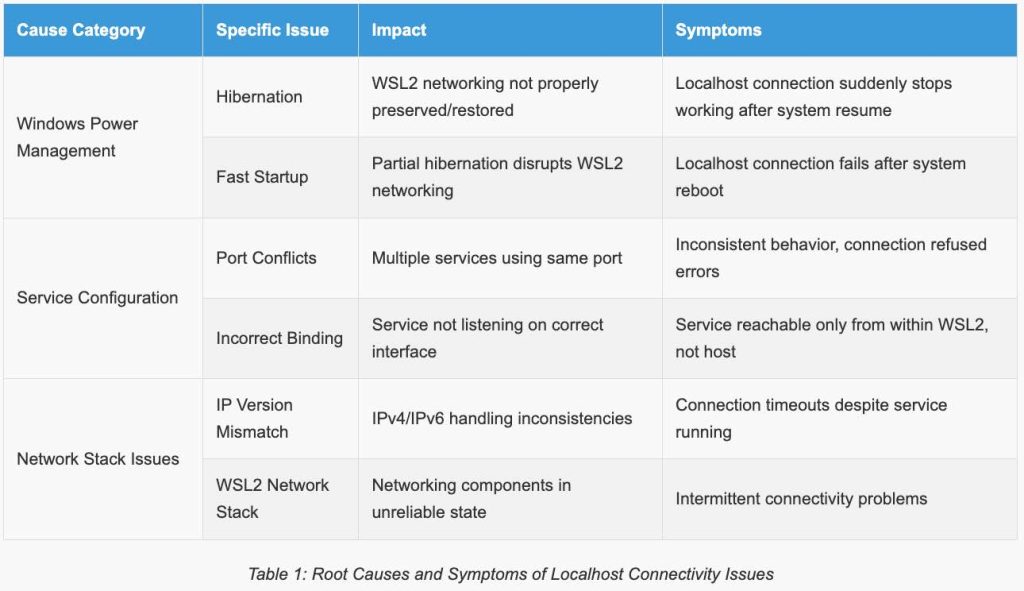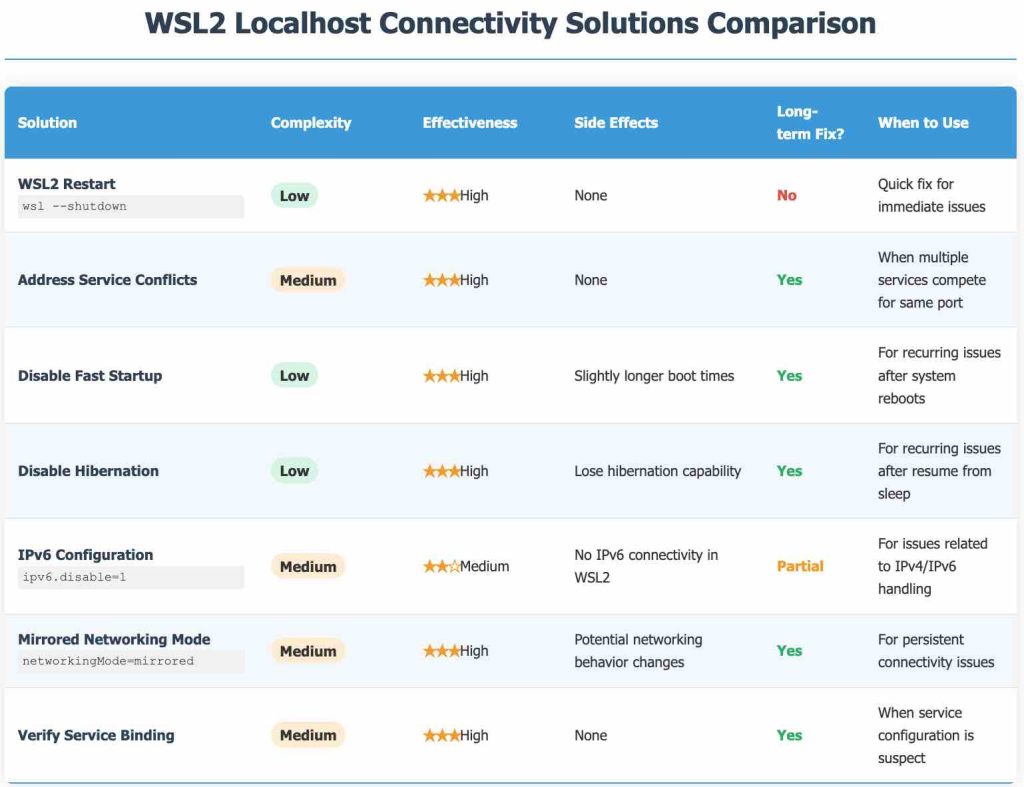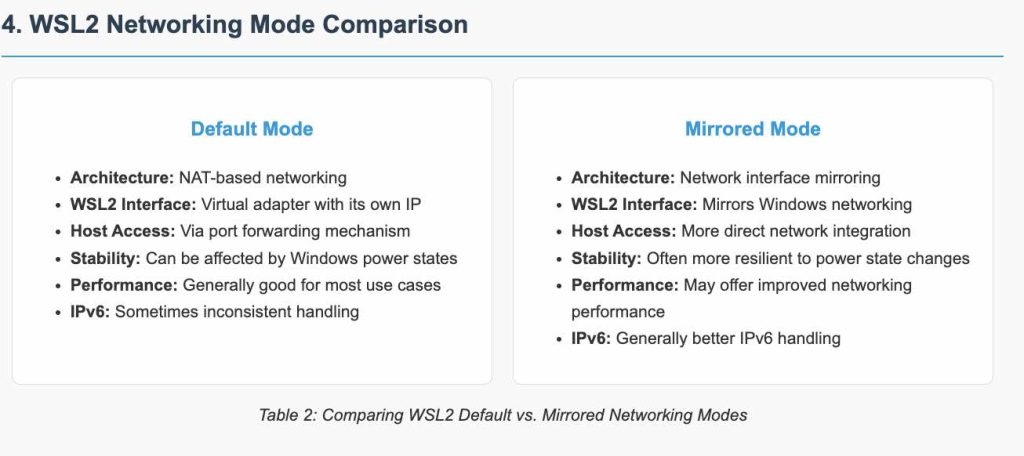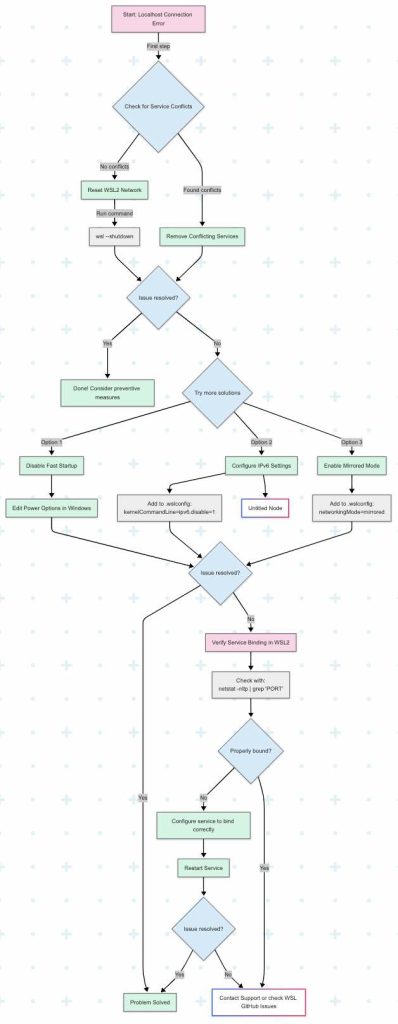Developers using Windows Subsystem for Linux 2 (WSL2) for web development occasionally encounter a frustrating issue: their web application, running within the WSL2 instance and seemingly configured correctly,
becomes inaccessible from the Windows host browser via localhost or 127.0.0.1 on a specific port (e.g., https://localhost:8000).
The browser typically displays an error message like “This site can’t be reached” or “localhost refused to connect.” Interestingly, the application might still be reachable using WSL2’s internal IP address, but this workaround can be inconvenient for development workflows, especially those involving database tools or other services expecting localhost resolution.
This article delves into the common causes behind this intermittent connectivity problem and outlines several effective solutions derived from established practices to restore seamless localhost access to your WSL2 services.
Understanding the “Localhost Refused to Connect” Error in WSL2
The ability to access services running inside WSL2 via localhost on the Windows host is a key feature known as “localhost forwarding.” When this mechanism functions correctly, network ports opened by applications within WSL2 (like a web server) are automatically made available on the Windows host’s localhost interface.
However, this forwarding can sometimes break down. The primary culprits often involve the power state management features of Windows:
- Windows Hibernation: When the Windows system hibernates, the state of WSL2’s networking components may not be perfectly preserved or restored upon resume, leading to a breakdown in localhost forwarding.
- Windows Fast Startup: This feature, enabled by default in many Windows installations, uses a form of pseudo-hibernation to speed up boot times. Unfortunately, it can trigger the same networking issues for WSL2 as full hibernation.

Beyond these primary causes, other factors can contribute to or exacerbate the problem:
- Service Conflicts: Running multiple web servers or services attempting to use the same port within WSL2 can lead to unpredictable behavior.
- IP Version Mismatches: In some scenarios, discrepancies in how IPv4 (
127.0.0.1) and IPv6 (::1) are handled forlocalhostbetween Windows and the WSL2 application might cause connection failures. - WSL2 Networking Stack Issues: Occasionally, the WSL2 networking stack itself might require a reset or reconfiguration.
Read: How to Configure X11 Forwarding for WSL2
Solutions to Restore Localhost Connectivity
The following solutions address the various causes of the “localhost refused to connect” error, ranging from initial configuration checks to more advanced WSL2 settings.

1. Addressing Service Conflicts (Initial Check)
Before diving into WSL2-specific networking fixes, ensure that no conflicting services are running within your WSL2 instance. For example, if you are using a development server provided by a framework (like symfony serve), running a separate full-fledged web server (like Apache2 or Nginx) to serve the same application on the same port is unnecessary and can cause conflicts.
Consider a startup script that initiates multiple services:
#!/bin/sh
# Example: Script attempting to configure Xdebug and start services
HostMachineIP=`cat /etc/resolv.conf | grep nameserver | sed 's/nameserver\s//'`
sed -i -E "s/client_host=[0-9\.]+/client_host=$HostMachineIP/g" /etc/php/#YOUR_PHP_VERSION#/mods-available/xdebug.ini
# Services that might conflict if a framework's development server is also used
service php#YOUR_PHP_VERSION#-fpm start
service apache2 start
service mysql start
If you intend to use a command like symfony serve -d, which starts its own development server (often utilizing PHP’s built-in server capabilities), you typically do not need to start apache2 or php-fpm services separately for that Symfony project. Simplify your startup process to only run the necessary services (e.g., mysql start and then symfony serve -d).
Why this could be helpful: This prevents port conflicts and ensures that the intended development server is the one responding to requests on the specified port.
WSL2 Troubleshooting Flow Diagram – (Image may be scalable)
2. Resetting WSL2’s Network Configuration
A common and often effective quick fix is to completely shut down and restart the WSL2 subsystem. This action forces a reset of its networking components, including the localhost forwarding feature.
Performing a WSL Shutdown
- Ensure all WSL2 distribution terminal windows are closed.
- Open a Windows Command Prompt or PowerShell.
- Execute the following command:
wsl --shutdown - After the command completes, restart your WSL2 distribution (e.g., by opening its terminal).
This procedure effectively reinitializes the WSL2 virtual machine and its networking stack, often resolving transient issues with localhost forwarding.

3. Preventing Future Disruptions: Disable Fast Startup and Hibernation
To address the root cause of frequent localhost forwarding failures related to system power states, consider disabling Windows Fast Startup and, if not essential for your workflow, Hibernation.
Consult the official Windows documentation or system settings for instructions on how to disable these features, as the specific steps can vary slightly between Windows versions. Typically, Fast Startup options are found within Power Options in the Control Panel.
Why this could be helpful: Disabling these features ensures a cleaner shutdown and startup cycle for the underlying system components that WSL2 relies on for networking, leading to more stable localhost forwarding.
Read: How to Fix the ‘System has not been booted with systemd’ Error in WSL
4. Configuring WSL2 IPv6 Behavior
If localhost connectivity issues persist, especially if they seem related to IP version preferences, modifying WSL2’s handling of IPv6 might offer a solution. There’s a possibility that an application within WSL2 listens on an IPv6 address for localhost, while the Windows host attempts connection via IPv4, or vice-versa, leading to failed connections.
You can disable IPv6 within WSL2 by editing the .wslconfig file located in your Windows user profile directory (%USERPROFILE%\.wslconfig). If the file doesn’t exist, create it.
Add the following configuration:
[wsl2]
kernelCommandLine=ipv6.disable=1
After saving the file, perform a wsl --shutdown and restart your WSL2 instance for the changes to take effect.
This forces WSL2 and applications within it to operate primarily over IPv4 for loopback communication, potentially resolving conflicts arising from mixed IPv4/IPv6 handling of localhost.
Consideration: Disabling IPv6 is a significant network alteration. In some cases, this setting can prevent port forwarding altogether or might only provide a temporary fix. Evaluate its impact carefully in your environment.
Alternatively, if this approach works, it might indicate that explicitly using 127.0.0.1 (for IPv4) or ::1 (for IPv6) instead of localhost when accessing the service from Windows, or configuring the service inside WSL2 to explicitly listen on both IPv4 and IPv6 loopback addresses, could be a more targeted solution.
5. Advanced Networking: WSL2 Mirrored Mode
For users seeking a potentially more robust networking experience with WSL2, Microsoft has introduced a “mirrored” networking mode. This mode can sometimes resolve complex localhost forwarding and general networking issues.
To enable mirrored networking mode, add or update your %USERPROFILE%\.wslconfig file with the following:
[wsl2]
networkingMode=mirrored
Ensure you exit all WSL distributions and then run wsl --shutdown from a command prompt. Restart WSL for the changes to apply.
Mirrored mode changes how WSL2 integrates with the Windows networking stack, potentially offering improved compatibility and reliability for features like localhost forwarding.
Read: How to Access Serial Ports (COM & ttyS) in Windows Subsystem for Linux (WSL1 & WSL2)
6. Verifying Service Binding within WSL2
It’s crucial to ensure that the web service inside your WSL2 instance is listening on an appropriate network interface and port. While localhost forwarding issues often stem from the Windows side or the WSL2 bridge, verifying the service’s listener is a fundamental check.
Within your WSL2 terminal, you can use tools like netstat or ss to check active listeners. For a service expected on port #YOUR_PORT# (e.g., 8000):
sudo netstat -nltp | grep '#YOUR_PORT#'
# or
sudo ss -tulnp | grep '#YOUR_PORT#'
Look for an entry indicating your service is listening. For localhost access from Windows to WSL2, the service within WSL2 should typically listen on 0.0.0.0:#YOUR_PORT# (all IPv4 interfaces) or 127.0.0.1:#YOUR_PORT# (loopback interface within WSL2).
If it’s listening on 127.0.0.1 (loopback), the WSL2 localhost forwarding feature is responsible for bridging this to the Windows localhost.
If your Symfony application (or other web server) indicates it’s running on https://127.0.0.1:8000 (as seen from within WSL2), this is generally correct for WSL2’s localhost forwarding to work. The issue then lies with the forwarding mechanism itself rather than the application not listening correctly within its own environment.
Verification Steps
After applying one or more of the solutions above, verify if the issue is resolved:
- Ensure your web application or service is running inside WSL2.
- Open your web browser on the Windows host.
- Attempt to access the service using
http://localhost:#YOUR_PORT#orhttps://localhost:#YOUR_PORT#(e.g.,https://localhost:8000).
If the application loads as expected, the connectivity issue has been resolved.
Conclusion
Intermittent “localhost refused to connect” errors when working with WSL2 can significantly disrupt development. These problems often originate from the interaction between WSL2’s networking and Windows power management features like Fast Startup and Hibernation.
Developers can achieve reliable localhost access to their WSL2-hosted applications, by addressing potential service conflicts, resetting the WSL2 networking state, making persistent changes to Windows power settings, or adjusting WSL2’s network configuration (such as IPv6 handling or enabling mirrored mode),.
Regular verification of service bindings within WSL2 also remains a good practice for general troubleshooting.




